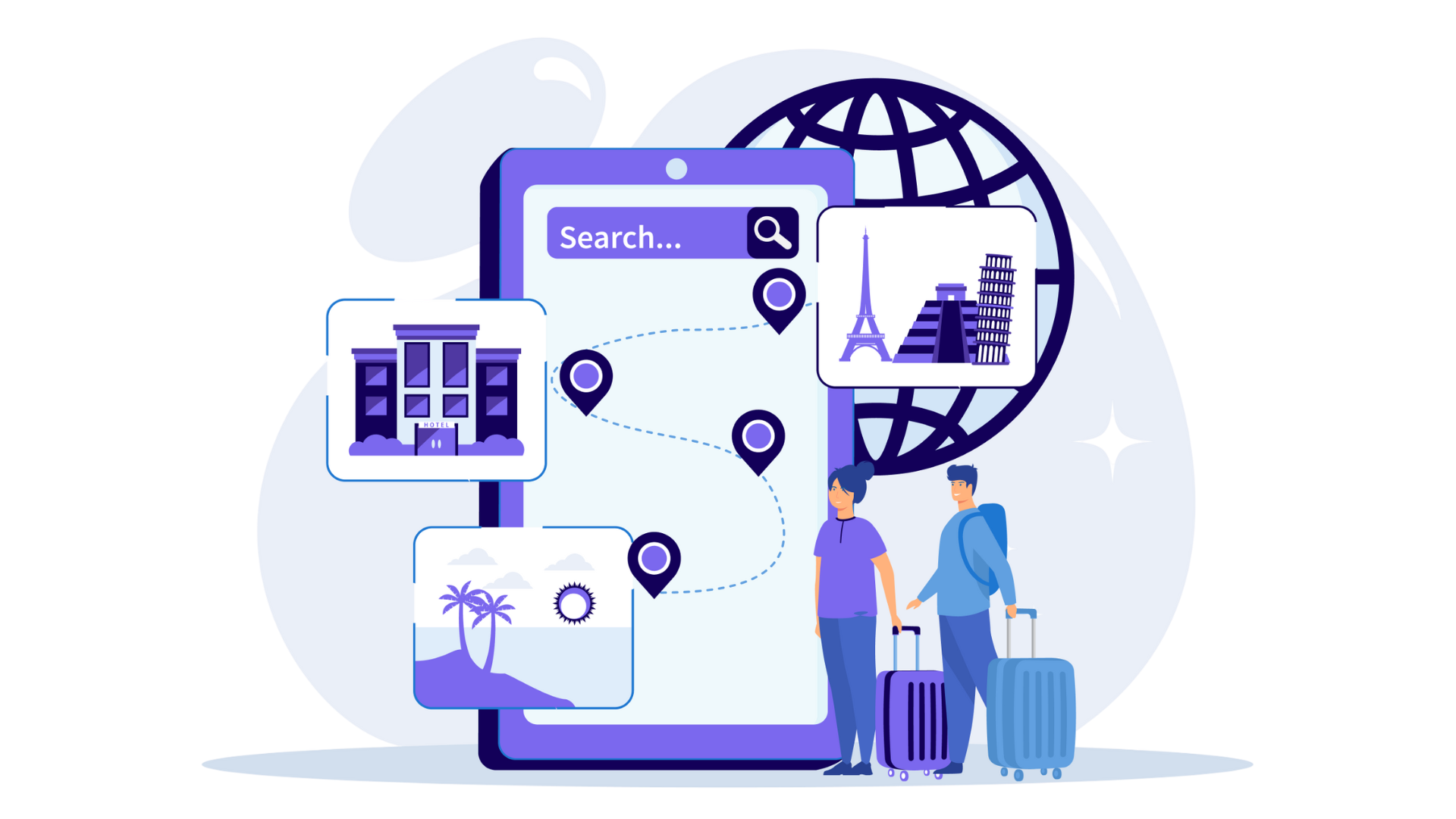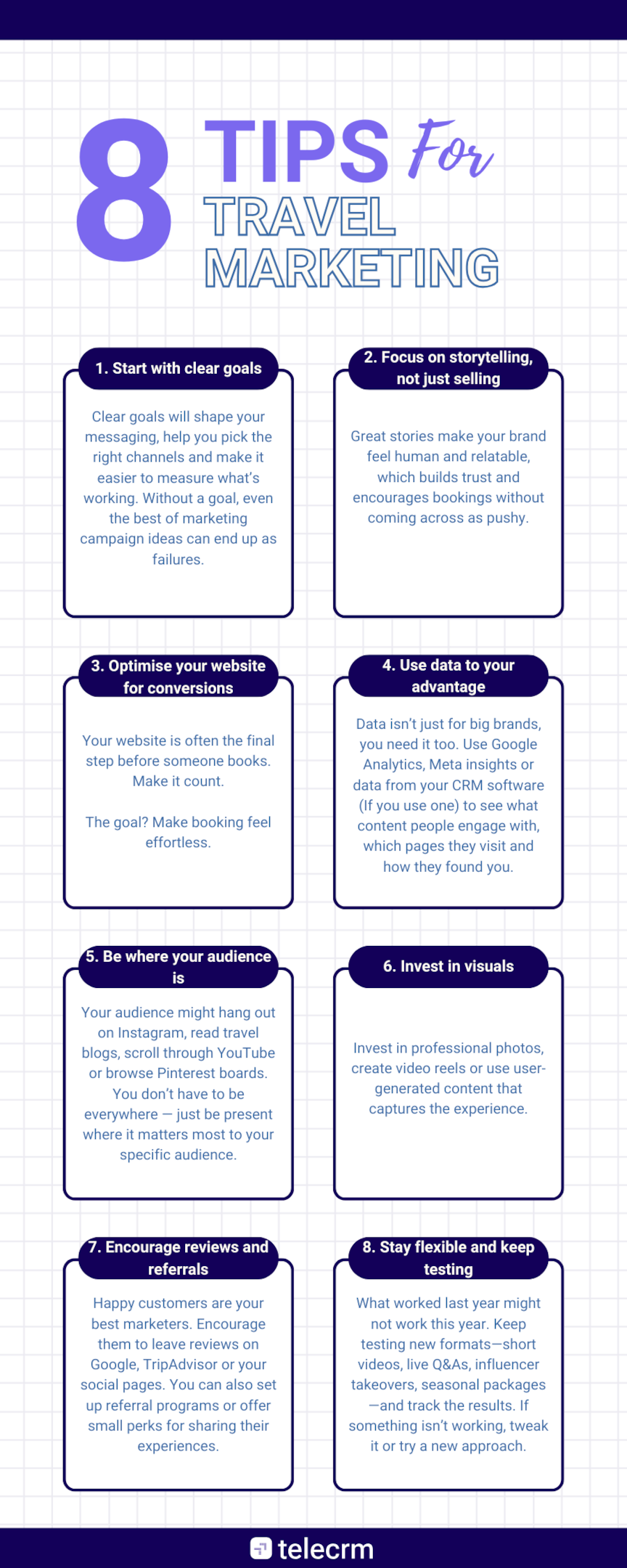
With global passenger traffic forecast to hit a staggering 9.9 billion in 2025, the question isn’t if people will travel but whether they’ll choose you or not. Attracting these travellers requires smart and strategic travel marketing. Whether you’re a hotel, a travel agency or a niche tour operator, reaching your audience effectively is crucial. Travellers today have endless choices, and standing out has never been more important.
To succeed, you need to understand exactly what your travellers want and how to communicate your offer clearly. Effective marketing does more than promote your tourism business — it helps connect emotionally, creates trust and inspires action.
In this blog, you’ll learn precisely how to position your travel business, craft engaging content and build a presence that converts this growing market into loyal, returning customers.
It is simply about how brands in the travel industry communicate with their potential customers to encourage them to choose their services and become loyal advocates. It goes beyond simply promoting discounts or showing off beautiful locations through ads. At its core, travel marketing means telling stories that resonate with people, tapping into their dreams, desires and emotions to inspire them to book their next holiday or adventure with you.
It’s a blend of digital strategies like social media marketing, influencer partnerships, content creation and targeted advertising. Not only that, you must understand exactly who your customers are, what motivates them and how best to reach them at different points in their decision-making journey.
Smart marketing doesn’t just bring in bookings — it builds your brand, deepens customer loyalty and drives long-term growth. Let’s break down exactly what it brings to the table.
The most obvious benefit? You get seen. Travel marketing helps you show up where your customers are — whether they’re browsing Instagram for inspiration, Googling destinations or reading travel blogs. A strong marketing strategy makes sure your brand appears in the right places, at the right time, in front of the right people. More visibility means more enquiries, more bookings and more growth.
In travel, trust is everything. People aren’t just buying a service — they’re putting their time, money and expectations in your hands. Great marketing builds that trust. Whether it’s a professional-looking website, positive reviews, helpful content or a strong social presence, every touchpoint reassures travellers that you’re dependable, experienced and worth choosing.
People don’t just remember the great package you got them the first time — they remember how you made them feel. Travel marketing, especially when it’s driven by a story and focused on customers, helps create emotional connections. These connections turn into loyalty. Loyal customers come back, book more and become your biggest advocates, recommending you to friends and family without a second thought.
Marketing isn’t just about talking — it’s also about listening. Every campaign, post and click gives you valuable insight into what your audience wants, what works and what doesn’t. Over time, you get a clearer picture of who your ideal customer is, allowing you to tailor your messaging, services and offers for maximum impact.
Let’s face it — the travel industry is packed with options. Effective marketing gives you an edge. It highlights what sets you apart, whether it’s your local expertise, personalised service or unique experiences. When done well, marketing doesn’t just make you visible — it makes you unforgettable.
The real win? Long-term success. Marketing creates a steady flow of awareness, interest and customer engagement. It’s not a one-time push — it’s a system that keeps working for you. With consistent effort, you create a self-sustaining cycle of attracting, converting and retaining customers that helps your business grow year after year.
A successful travel marketing strategy isn’t about doing everything — it’s about doing the right things to perfection. Here’s a breakdown of the key building blocks that will make your marketing truly standout:

Before you post a reel or run an ad, you need to know who you’re talking to. Are they solo backpackers, luxury travellers, adventure seekers or families looking for a stress-free holiday? Understanding your target audience — their needs, habits, dreams and challenges — helps shape every message you put out. The more specific you are, the more your marketing will resonate and convert.
In travel marketing, content is everything. People want to see it before they buy it. High-quality visuals, engaging blogs, destination guides, reels and even customer stories bring your offering to life. Good content doesn’t just sell—it inspires. It should answer questions, spark curiosity and make people want to pack their bags and go.
Everyone today researches online content for queries, so your digital presence needs to be rock solid. A clean, mobile-friendly website with clear CTAs and up-to-date information is a must. Your brand should also be active on social media platforms, ranking on Google and must have a presence on other platforms where your audience spends time — whether on Pinterest, YouTube or travel forums.
If your website doesn’t rank in top results on Google, you’re invisible to most travellers. SEO ensures that when someone types “best trekking tours in Manali” or “budget beach holidays in Goa,” your tourism business shows up in the results. From optimising blog posts to building backlinks and using the right keywords, SEO helps increase visibility without having to pay for ads. Partnering with a professional SEO company can further enhance your strategy, ensuring you stay ahead of competitors and maintain strong search engine rankings.
In travel, who you know can be as powerful as what you offer. Collaborating with influencers, bloggers, local guides, hotels or even other travel brands can help you tap into new audiences quickly. Strategic partnerships build credibility, expand reach and often result in content or offers that feel more authentic than traditional advertising.
Travel is personal — and your marketing should reflect that. Whether it’s recommending trips based on past bookings, sending customised emails or showing tailored offers based on user behaviour, personalisation makes your audience feel seen and valued. The customer experience starts before the trip. If your marketing feels generic, you risk losing travellers to brands that speak more directly to their needs.
Travellers trust other travellers. That’s why reviews, testimonials and user-generated content like photos or stories shared by customers are gold for travel marketers. Featuring real people and their experiences builds credibility and relatability. UGC also gives you fresh, authentic content without having to create everything yourself. Encourage customers to share their trips and tag your brand, then showcase their stories on your platforms.
Together, these components form the foundation of a travel marketing strategy that not only reaches the right people but also inspires them to choose you. Each piece plays a role in building trust, generating interest and turning desires into action.
Travel marketing has endless potential, but it also comes with a unique set of challenges.
1. High competition | Whether you're a small tour operator or a large hotel chain, you’re competing against countless others offering similar destinations, packages or experiences. Standing out in this saturated market requires not just creativity but also clarity. You need to communicate what makes you different—and why that difference matters to your audience. |
2. Changing customer behaviour | Today’s travellers aren’t the same as they were even a few years ago. They research more, expect quicker responses and want highly personalised experiences. They value sustainability, seek unique local adventures and often book through mobile or social media. Keeping up with these shifting preferences means constantly adapting your marketing strategy, which can be overwhelming if you don’t have the right tools or resources. |
3. Reliance on third-party platforms | Many travel companies depend heavily on third-party platforms like OTAs (Online Travel Agencies), social media or search engines to attract customers. While these channels offer visibility, they also come with risks — algorithm changes, rising ad costs or platform policy updates can suddenly impact your reach or revenue. Building a strong direct marketing channel, like email lists or a loyal community, helps reduce this dependency. |
4. Budget constraints | Marketing is expensive — especially when you’re trying to compete with big players who have funding. Small and medium-sized (SMEs) businesses often struggle to keep up with paid ads, influencer partnerships or professional content creation. This makes it vital to find low-cost, high-impact strategies like organic content, partnerships or community engagement that can stretch your budget further. Pro tip: Get accounting software for travel agency and keep track of all your finances in a single place. |
5. Measuring ROI | It’s not always easy to track what’s working. Someone might see your Instagram post today, visit your site a week later and book through an OTA a month down the line. Attribution is tricky, and without proper tracking tools, it’s hard to measure what’s driving results. This can make it difficult to justify spending or optimise campaigns effectively. |
Pro tip: Get a travel management system to improve efficiency and effectiveness of not just your marketing efforts but overal business.
Creating a travel marketing strategy that actually works doesn’t mean throwing money at ads or posting pretty pictures every other day. It’s about building a plan that aligns with your audience, your brand and your business goals. Here are some practical, proven travel marketing tips to help you craft a strategy that not only attracts attention but drives real results.

Before you create content or run campaigns, know what you’re trying to achieve.
Are you looking to increase direct bookings,
Grow your social media following or
Drive enquiries for a new package?
Clear goals will shape your messaging, help you pick the right channels and make it easier to measure what’s working. Without a goal, even the best of marketing campaign ideas can end up as failures.
Travellers are motivated by emotion — curiosity, nostalgia, excitement and even fear of missing out. Use storytelling to tap into those emotions. Share real customer experiences, behind-the-scenes moments or the story behind your destination or service. Great stories make your brand feel human and relatable, which builds trust and encourages bookings without coming across as pushy.
Your website is often the final step before someone books. Make it count. Ensure it loads quickly, works well on mobile and has clear calls to action like “book now” or “enquire today.” Add high-quality images, updated contact info, reviews and an easy-to-navigate layout. The goal? Make booking feel effortless.
Data isn’t just for big brands, you need it too. Use Google Analytics, Meta insights or data from your travel agenecy software (If you use one) to see what content people engage with, which pages they visit and how they found you. These insights can help you refine your targeting, test new ideas and double down on what works. Over time, data-driven digital marketing becomes smarter and more efficient.
Your audience might hang out on Instagram, read travel blogs, scroll through YouTube or browse Pinterest boards. You don’t have to be everywhere — just be present where it matters most to your specific audience. Tailor your message for each platform instead of copy-pasting the same content. Consistency matters, but relevance matters more.
In the travel industry, visuals sell the dream. Poor-quality photos or dull videos can put people off, no matter how great your service is. Invest in professional photos, create video reels or use user-generated content that captures the experience. And remember — it’s not just about the destination. Show the food, the people, the culture and the little moments that make a trip memorable.
Happy customers are your best marketers. Encourage them to leave reviews on Google, TripAdvisor or your social pages. You can also set up referral programs or offer small perks for sharing their experiences. People trust other travellers more than they trust ads, so let your customers do some of the talking for you.
What worked last year might not work this year. Keep testing new formats—short videos, live Q&As, influencer takeovers, seasonal packages—and track the results. If something isn’t working, tweak it or try a new approach. The best travel marketers are the ones who stay curious and never stop learning.
When you’re in the travel and tourism industry, marketing isn’t something you can ignore. It’s what helps people find you, trust you and choose you over others. With more people travelling in 2025 than ever before, the opportunity is huge — but only if you’re visible and clear about what you offer.
You don’t need a big budget or a fancy team. You just need the right message, a bit of creativity and a solid plan. Focus on your audience, be where they are and show them why you’re worth a shot. Keep things simple, honest and helpful — and you’ll start seeing real results.
To help make things simpler and easier for you, book a demo of Telecrm (India’s simplest Travel CRM) to experience firsthand how it helps you achieve your goals, provides detailed analytics and increases revenue from day 1 of implementation. In travel, first impressions matter. Make yours count.


© Copyright 2025 Telecrm.in - All Rights Reserved • Privacy Policy • T&C


© Copyright 2025 Telecrm.in - All Rights Reserved • Privacy Policy • T&C